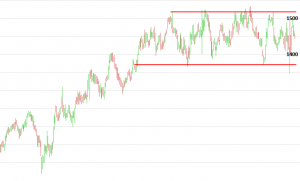The information on this page is not a personal recommendation and does not take into account your personal circumstances or appetite for risk.
Support & Resistance is a simple concept used by traders to identify Buy and Sell signals
The concept can be found on the price chart of any tradable asset (shares, commodities, indices, currencies, bonds), with support where the price tends to bounce and resistance where the price tends to fall back. Think floors and ceilings (see below)
Support and Resistance reflect the relative enthusiasm of buyers and sellers for an asset and occurs when trading intensifies at certain levels. Their formation can be explained by looking at the psychology of buyers and sellers.
The market comprises 5 types of participants;
Support
When a price rises the Longs are happy (paper profit) and may look to buy more on any dips back to their entry price. The Shorts are unhappy at not closing earlier. They hold on waiting for the price to go as low as possible (note: closing a short requires buying).
The Uncommitted who were long are also unhappy as they should have held on. They look to buy back in on any dips. The Uncommitted who were short are happy and consider reversing their prior view and going long on any dips. The Uncommitted who never had a position believe now’s the time and so also look to buy on dips.
When the price falls back to the 5 group’s ‘psychological’ trigger point, aggregate demand exceeds supply and contributes to helping buoy the price and the formation of a support level.
Resistance
When a price falls the Longs are annoyed at holding on and look to sell on any rise back towards their purchase price. The Shorts are upbeat with positions in profit and look to sell short again on any rallies towards their original entry point.
The Uncommitted who closed long positions earlier are happy, and consider doing the reverse going short. The uncommitted who closed short positions earlier are unhappy at not staying in that position and look to short again on any rallies. The Uncommitted who were waiting on the sidelines decide now’s the time to jump in, and look to short on any rallies.
Once again, when the price gets to everyone’s ‘trigger’, the aggregate activity groups results in more selling/shorting pressure on the price and so a resistance level forms.
Example: Price chart UK water utility company Severn Trent (SVT.L)

A range-trader using support and resistance could have used the 1400p and 1500p levels for Buy and Sell signals, generating a healthy profit. Note price past performance is no guarantee of future results, and risk management is important.
Summary
The more trading that occurs at a level levels, the more of a vested interest (bullish or bearish) develops, increasing the likelihood it proves supportive/resistant in the future and can be trusted as a potential signal.
If the appetite of a group is ever disturbed, resulting in more/less buying/selling pressure, a level can be breached and the price rise/fall towards before a new level is formed in the way discussed
The longer a level goes unbroken and the more times it is tested, the more significant any breach is. When a level is broken it is also tends to reverse its role, with those nursing losses wanting to exit at the best price possible and those who missed the change of trend wanting to enter at the best price.
If you can identify which market participant you are at any one time, and which emotion you are experiencing (profit or loss?; position or waiting) you can see how you contribute to formation of support/resistance.
Caveat
Individual technical indicators shouldn’t be relied upon in isolation for trading decisions, however strong the signal. Others should be consulted for extra help, while price (price, price patterns, support/resistance, moving averages, trendlines) and volume should confirm continuation or change of trend. Trend should always be respected as pre-empting a change can prove costly.